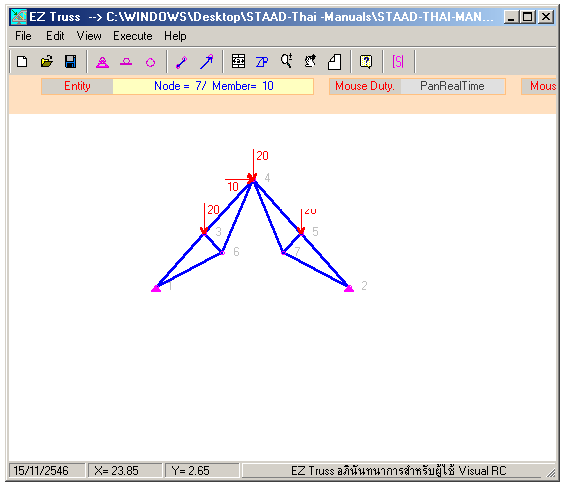Free Truss Analysis Software Download
The Truss Analysis Program What it teaches: • This program teaches you how to design a planar (2 dimensional) truss, • It teaches you how, by counting equations and unknowns, you can assess the stability of a truss (for example a triangle is stable but a rectangle is not), • It shows how the assumption that the forces are in balance at every joint gives rise to a system of equations, • It shows how the system of equations can be solved to give the tension or compression in each member (bar) of the truss and the force on each support of the truss. How it works: There are three steps: • Step 1: You design the truss. You select the Member tool (the leftmost tool on the toolbar) and then click and drag the mouse in the drawing area to create a truss member with a joint at either end. You repeat to add more members. (There are features such as snap to grid and snap to object to ensure that the members connect end-to-end at the joints.) You add forces (using the second tool) to load down your truss and you add supports (using the third and fourth tools) to hold up your truss.
Here is a screen shot of a Parker truss: • Step 2: You number the joints and give names to the forces in the truss members and the forces on the supports. This can be sped up by just letting the program choose the names by clicking on AutoName. • Step 3: You let the program analyse the truss and you view the reports. To do the analysis the program assumes that: • Every member of the truss is under some unknown compression and is therefore providing a force toward the joint at either of its ends. This is indicated by the red arrows on all of the members. (If it turns out that some member is in fact under tension, this will result in a negative answer for that force.) • The truss is in equilibrium (standing still). This means that at every joint two equations hold: the forces right = the forces left, and the forces up = the forces down.

Truss analysis free download - Structural Analysis II, Truss Me!, Truss Music, and many more programs. Related: truss design software. Structural Analysis II. Free Structural Analysis. You can download 2D Truss Analysis 2.0 from our software library for free. The following version: 2.0 is the most frequently downloaded one by the program users.
For this example there are 9 joints x 2 equations / joint = 18 equations. The program gives several reports: • The number of equations and number of unknowns, and the implications for the stability of the truss.
For this truss there are 18 equations and 18 unknowns, so a unique solution and hence stability is possible. • A listing of the system of equations for the entire truss.
Also, by clicking on a joint, you can see the pair of equations that hold at that joint. The screen shot below shows an example. • A listing of the system of equations for the entire truss reduced to RREF (reduced row echelon form) thus giving the solutions of the equations. Here is a screen shot showing the equations that are displayed if you click on joint 9 or joint 7 (the forces right = the forces left, and the forces up = the forces down). Here is a screen shot of all of the equations assembled into an augmented matrix. Here is a listing of the forces (the solution of the system of equations).

The load that was placed at the middle of the span was 1000. Notice that: • B and C each support half of this load (500). • A is zero because the load was applied straight down. Samij luchshij virtualjnij sintezator korg. Raspechatatj shablon applikacii na 23 fevralya.
• Forces R, S, and T are all positive indicating that members near the top of the truss are under compression and forces D, E, and F are all negative indicating that members near the bottom of the truss are under tension. • The biggest forces are Q and R at the very top of the truss so we should make those members extra strong. Some ideas for teachers: • The program comes with a helpfile that explains statics and truss analysis. • The program comes with sample trusses files that result in overdetermined, inconsistent and redundant systems of equations. • Start by building some very simple ‘trusses’ such as one having just one roller support, one member, and one force attached to it. You will get an inconsistent system of equations, which means that the assumption of equilibrium is invalid, so the truss will collapse. • This is a great application of trigonometry.